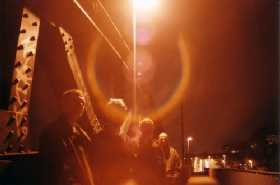Böhren Und Der Club Of Gore

**»Frío bajo el calor»
Böhren Und Der Club Of Gore**
**»The Uncanny in the Ordinary»
Böhren Und Der Club Of Gore**
En música existen etiquetas de todo tipo, en algunas ocasiones nos sirven para orientarnos o darnos cierta idea sobre lo que vamos a escuchar, o bien, nos pueden resultar confusas o en extremo creativas, al límite de desorientarnos.
La agrupación que vamos a comentar suele autoclasificarse irónicamente como “horror jazz” o “piano doom”, y se forma en Alemania en 1986 en Mülheim an der Ruhr, como un cuarteto.
Amigos desde la época escolar, experimentan en un comienzo dentro de estilos como el grindcore, hardcore y el death/doom metal (“7 Inch Boots” se llamó la banda de aquella época), lo que finalmente los aburre de sí mismos, impulsando la necesidad de cambio y búsqueda. La respuesta fue la formación de Böhren und der Club of Gore (BUDCOG) en 1992, tomando como referencia la banda instrumental holandesa de nombre Gore, la que los sedujo a la idea de no utilizar voces en sus creaciones; dicho sea de paso, la palabra Böhren significa taladrar.
El nuevo rumbo tiene su primera entrega en “Gore Motel” en 1994 y “Midnight Radio” en 1995, ambos editados por el sello Epistrophy (junto a otros 7” por el mismo sello). Böhren ha mantenido de alguna forma la estructura de una banda rock, con un sonido minimalista, fragmentado, oscuro y ambiental, de difícil acercamiento a oídos sin entrenamiento.
Desde el comienzo BUDCOG muestra la importancia que le atribuye a la gráfica de sus discos, los títulos de las pistas (la única presencia explícita de un mensaje explícito), y por supuesto la música, donde el trabajo de estudio toma su tiempo, no hay urgencia ni premura. La contradicción entre la gráfica y la música, incluso el nombre de la banda, es evidente, se juega con la percepción del auditor, de la imagen previa que uno pueda hacerse de quienes están detrás de todo esto y de cómo sonarán.
El alejamiento de la banda de Reiner Henseleit en 1996 marcará una nueva etapa en la agrupación, permaneciendo en Böhren Thorsten Benning (batería), Morten Gass (piano, rhodes), Robin Rodenberg (doble bajo), y uniéndose a ellos Christoph Clöser (saxofón, piano, rhodes). La llegada de Clöser significa sonoramente que la guitarra desaparecerá de los temas, adquiriendo relevancia el piano y el fender rhodes.
El sello de Hamburgo Wonder, editaría en el 2000 “Sunset Mission” y “Black Earth” en 2002, trabajos en cierta medida hermanos, como los dos primeros editados anteriormente. El sonido se ha vuelto notoriamente más accesible y profundo, con la presencia envolvente del saxo y una base batería/bajo aletargada, de valiosa potencia. Nos trasladamos hacia un sonido tipo Angelo Badalamenti, sentimos a Twin Peaks como si estuviera a la vuelta de la esquina.
En una de las pocas entrevistas disponibles, Morten Gass comenta: **“En Black Earth trabajamos con temas como el asesinato, el horror, los funerales y el fin del mundo. Estamos muy contentos con el álbum globalmente (música, sonido, títulos, carátula), debido a que tuvimos todo el tiempo del mundo para elaborarlo. El álbum es un 100% musicalmente lo que teníamos en mente.”**
BUDCOG logra en ambas producciones un contrapunto que se encuentra al borde de una normalidad aparente y de algo secreto, encubierto, lo que David Lynch logra con maestría en el cine. Como buena obra, permite lecturas múltiples, pudiendo elucubrar que detrás de la calidez sonora habita algo terminal y no tan normal. Este aspecto, que para algunos es equivalencia de placer auditivo, logra la progresiva adicción a la agrupación, al estado mental que sugiere y al relajo que proporciona.
Como se ha escrito, con cada nueva producción Böhren und der Club of Gore se acerca cada vez más al fin del mundo, lo que se confirma con la última producción editada a la fecha “Geisterfaust”, con un sonido al hueso y menos agresivo, con citas a su primera época minimalista, sin duda una de las producciones destacadas del 2005. A los que deseen partir conociéndolos les sugiero “Sunset Mission” como punto de arranque.
Francisco Bernet
Mayo 2006
Musical nomenclature is a multifarious beast. At times it can faithfully guide the listener, giving an essential indication of what is in store; but at others it simply confuses matters, disorienting the prospective consumer no end.
The quartet in question, whose music its members have sardonically referred to as “horror jazz” or “piano doom,” was formed in 1986 in Mülheim an der Ruhr, Germany.
Under such names as 7 Inch Boots, Chronical Diarrhea and Macabre Farmhouse, these schoolhood friends dabbled in a variety of genres (grindcore, hardcore and death/doom metal) to no great consequence; this perceived failure and resulting tedium impelled them onward in search of new paths. A breakthrough was attained with the founding of Böhren (German for drilling) in 1992, the band name expanding later on to include “und der Club de Gore” in honor of Dutch rock band Gore whose instrumental music influenced the band’s subsequent course.
This new direction bore fruit in the form of several 7”s and two longplayers released on Epistrophy, Gore Motel, in 1994, and Midnight Radio, the following year. Throughout its career Böhren has retained a rock aesthetic, a challenging dark ambient sound vividly described on their official website as an “unholy ambient mixture of slow jazz ballads, Black Sabbath doom and down tuned Autopsy sounds.” From its inception BUDCOG involved itself in all aspects of music making and production, as evinced by a conscientious use of studio time and its multifarious potentials – a certain pretence to mystification clearly being sought by means of the glaring incongruity between packaging, band name, artwork, track listing (song titles are unequivocally laden with meaning) and, most importantly, the music.
A new page was turned with the departure of guitarist Reiner Henseleit in 1996; joining the ranks of Thorsten Benning (drums), Morten Gass (piano, Fender Rhodes, Mellotron) and Robin Rodenberg (double bass), new member Christoph Clöser (saxophone, piano, Fender Rhodes) profoundly altered the band’s guitar-centered sound for one more keyboard-driven. The twin works of Sunset Mission (2000) and Black Earth (2002), released by Hamburg-based imprint Wonder, reveal this new approach: a far more accessible and pellucid sound is achieved by means of languid saxophone lines that hover over somnolent rhythmic currents in a fine approximation to Angelo Badalamenti.
In a rare interview, Morten Gass explained that **“Black Earth is a doom record (in most kinds of ways). We just deal with themes like ‘murder’, ‘horror’, ‘funeral’ and ‘the end of the world’. We are very happy with the whole album (music, sound, titles, cover), because we had all the time in the world to come up with such a record. It is 100% the music that we had in mind.”**
In both works, a semblance of ordinariness is counterpointed by layers of uncanniness, not unlike that unsettling preternaturalness evoked by David Lynch. Like all solid efforts, Sunset Mission and Black Earth bear repeated listening – if only, to unravel the warm deceptive exterior in order to access something far more anomalous and ultimate lurking beneath the surface. This disambiguating process, which to discerning listeners constitutes one of the greatest rewards of music, coupled with the emotional conditions of tension and relaxation drawn forth by the band tends to foster a progressive fascination with the music. With each release Böhren und der Club of Gore has inched itself closer and closer to a pure state of rarified nothingness, as demonstrated by Geisterfaust, a subtle, skeletal affair of minimalist jazz-tinged dirges — a highlight of 2005. For the novice, Sunset Mission, a collection of atmospheric jazzy numbers released in 2000, is as good a starting point as any.
Francisco Bernet & Francisca Monsalve
May 2006

